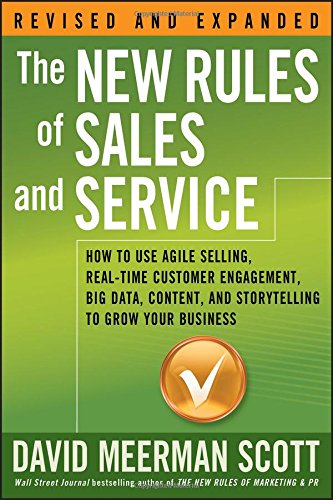Content Strategy – A Detailed Discussion About Modern Marketing and Sales
Today, we’re in the middle of the most important communications revolution in human history.
Technology has always brought about change in industry, but this revolution is unique because it’s bringing about significant changes in our behavior, preferences, expectations and even core values and norms.
It’s also causing people to change what they expect from the companies they do business with, and that means that many companies need to change how they communicate with their market.
Here, bestselling author and business strategist David Meerman Scott talks with Qlutch CEO Jim Sagar about how to design and execute a modern marketing strategy.
In this podcast you’ll learn:
- The 5 questions to ask your executive team to gain buy-in for a modern marketing approach
- How to determine if your existing marketing matches your buyers’ behaviors
- How to create a content strategy that is meaningful to your audience
- The skills you need to create content that your market will value
- How to integrate your sales team with modern marketing
- How to learn to communicate in real time with the rest of your market
 |
 |
|---|---|
| David Meerman Scott, Author & Strategist Books • Blog |
Jim Sagar, CEO of Qlutch Marketing Plans from Qlutch • LinkedIn |
Sales and service are being radically redefined by the biggest communications revolution in human history. Today buyers are in charge! There is no more ‘selling’—there is only buying. When potential customers have near perfect information on the web, it means salespeople must transform from authority to consultant, product narratives must tell a story, and businesses must be agile enough to respond before opportunity is lost. “Buyers today have so much more information than they did a decade ago. If you are using old school traditional sales models it’s probably time to rethink some things.” JJ Ramberg, host of “Your Business” on MSNBC.
|
 |
The Podcast: Content Strategy – A Detailed Discussion About Modern Marketing and Sales
 |
 |
And if you prefer text, here’s a transcript.
JIM: David, welcome. It’s great to have you here today!
DAVID: It’s great to be here Jim, thanks for having me on.
JIM: David, in one of your recent talks you said, “We are now going through the most important communications revolution in human history.”
I agree with that statement, as do many forward-thinking business analysts and marketing leaders. For those folks who are still learning about this revolution, how would you explain it to them at the highest level?
DAVID: 600 years ago approximately, the printing press was invented. And the printing press quite literally brought humanity out of the dark ages and ushered in the Renaissance, because books were widely available and because they were much, much cheaper to print than hand copying books. All of a sudden, people had access to books they never had before, so there was an incentive to learn how to read. And as people learned how to read and started to read books, they no longer had to trust their religious leaders for the truth, they no longer had to memorize laws; it was an unbelievable revolution in human history – the invention of the printing press.
Now almost 600 years later, the invention of smart phones (this little tiny device in your pocket that connects you in real time to practically every other human being on the planet) is the most important communications revolution (well, second to the invention of the printing press), and it’s literally doing the same kind of thing – it’s bringing people out of poverty because they can use their smartphones to conduct business. It’s helping kids to get educated in remote countries who weren’t able to get an international education before. It is incredible, there are more mobile phones in the world than there are working toilets. So quite literally, people would rather have a mobile phone when they get a few dollars in their pockets than a working toilet in their home! And it is absolutely revolutionary, the idea of real-time communications.
But the reason that I think this is so important to understand on a high level is because most companies, especially B2B companies, are operating as if this tool wasn’t available to us; they’re still doing their marketing and sales in the old way. They’re still spending a boatload of money to go to trade shows and try to influence people as they’re walking down the tradeshow aisles. They are still doing direct mail campaigns trying to reach people. They are still putting gates by the white papers trying to get sales leads. There are still having armies of sales people who are cold calling people trying to get them interested in a product or service. Now, if those things are working for your business, I’m not going to tell you to stop. But for most people, they’re not working so well, and you’ve got to be a part of the revolution.
JIM: David, that’s an amazing statistic that worldwide, more people have mobile phones than working toilets.
DAVID: Here’s another one for you as long as you’re interested in that, which I am. More people have smartphones than own a toothbrush!
JIM: That is amazing! I’ve seen statistics that show that we’re looking at our smartphones 1,500 times a week?
DAVID: There are some crazy numbers like that, but the point is when somebody has a problem either for their business or for their personal life, the first thing they do is go to the Web or their social networks. That’s what we all do, everyone. So if you’re selling a B2B product, enterprise software, a consumer product or if you’re selling a service or you’re a consultant – whatever it might be – your job is not to try to sell people, your job is to make it easier for them to buy.
And the tools of real-time connection available on the smartphone mean that you can easily reach people, in the way that they want to be reached, as they’re looking for products and services as well as companies to do business with.
JIM: Absolutely. David you talk about, and I talk about, the concept that what this has done is shifted the control over to the buyers – the buyers are the ones who are now in charge, and there is no longer any mystery in the sales process. There really is no selling, there is only buying. And what I see is that most corporate sales and marketing teams for newer companies understand this. But there are some executives of the traditional, established B2B companies that are still following that old pattern of interruption marketing and persuasive sales, and more of them are struggling than aren’t struggling. So I was curious about the advice that you would give to the marketing leaders in these “old-school” companies. How do they shift to this new model?
DAVID: Good questions. There still are a lot of people who are practicing the old ways, and the reason I believe that they’re practicing the old ways is because they are people who had tremendous success prior to the ability to reach people through the tools of real-time communications. They had tremendous success using the only way that B2B marketers could reach people, which were these old ways. They do the cold calling thing, they do the direct mail thing, they do the tradeshow thing.
And these organizations and these individual people had success, or the sales vice president said, “I made a lot of money cold calling and I got promoted a bunch of times by cold calling, and that means you have to cold call!” And the marketer says to the vice president of marketing, “You know, we did great by exhibiting at these five tradeshows for the last 20 years, so let’s keep doing it.” I think that’s the biggest problem.
I’ll give you another problem which very few people talk about, and that is the traditional form of salesforce automation tools and CRM systems. If you’re using a salesforce automation system or CRM system that was built five years ago or longer, by definition it’s been built prior to the new way of reaching people, prior to buyers being in charge. Therefore, it’s really just a tool for traditional selling – it’s a tool to automate traditional selling, and that is a really big problem. Most of those salesforce automation and CRM systems are used to manage salespeople rather than manage buying processes.
But what I would say to the second half of your question, what I would say to that marketing person who knows that they have to get with this modern program but has pushback within the organization, is that they have three choices:
- Choice number one: they can be an agent of change. They can be somebody who’s going to focus really hard on educating their organization and being the person who can affect change that their marketing can come into the modern way to do marketing.
- The second option they have is to just continue to draw a salary, do their job, say yes to their bosses and do something even though in their heart they know it’s wrong. There is nothing wrong with that, I mean, you draw salary and feed your family, okay.
- The third choice is to quit your freaking job and go find a company where you can do your thing. So that’s a third option.
Now, if you want to do the first option and you want to be an agent of change, I would say that you’ve got an opportunity to show the executives in your organization that they’re hypocrites. The way that you can do that is you can (and you need to do this nicely otherwise you may end up with a fight on your hands) bring the executives into a room and ask them a series of questions, or you observe their behavior and call them out for what they’re doing. And one of the typical things is that you’ll see is the vice president of sales will go into the mailroom, go to their mail slot, and pull out all of the direct mail that they receive and immediately drop it in the recycle bin. If you ask them what they’re doing, they say they’re getting rid of junk mail. And then two minutes later the VP of sales comes down the hall and talks to the marketing guy and goes, “Hey, we need a direct mail campaign to generate leads.” So you’re a freaking hypocrite, you just threw away all your so-called junk mail and now you’re asking me to create a so-called direct-mail campaign, what the hell is the difference? So you want to point out where people are being hypocrites.
Here’s an even better way, and this works best with the more people you can get to do it. If there’s an executive meeting with 10 people that’s great, if there are 20 people in the room that’s even better. Ask them these five questions:
- In the last two months, privately or professionally, have you purchased a product or service as the result of receiving a cold call from a salesperson?
- In the last two months, privately or professionally, have you bought a product or service as the result of receiving a direct-mail advertisement?
- In the last two months, privately or professionally, have you bought a product or service as the result of seeing an advertisement in a magazine or newspaper or regular television?
- In the last two months, privately or professionally, have you bought a product or service as a result of going to Google or another search engine?
- In the last two months, privately or professionally, have you bought a product or service that you tapped your online network for help around? Did you use any kind of electronic mechanism, whether social networks like Facebook or LinkedIn or Twitter or email or Skype or instant messaging, text or anything like that, and ask a friend or colleague or family member for advice about a product or service you were interested in?
No matter where I ask those questions, the answers are the same. And I’m sure for everybody listening right now, there’s almost nobody who would say yes to any of the first three questions, and every single one of you would’ve said yes to last two questions. The averages for the answers to those questions are:
- 1%
- 1%
- 10%
- 100%
- 95%
So then I say, “Fine, so no one in this room has bought a product or service as a result of receiving a cold call in the last couple of months. Nobody in this room has bought a product or service as a result of receiving a direct-mail advertisement in the last couple of months. Only one of you bought a product or service as a result of reading an advertisement. And every one of you has bought a product or service by doing independent research going to Google or another search engine. And every single one of you has bought a product or service as the result of asking a friend or a colleague or family member on a social network for advice. The first three answers are traditional marketing; the last two answers are modern marketing.”
You need to be in front of people when they’re doing that research, then you say to your colleagues, “We need to get ourselves in gear for the way that people are buying today.” So in a nice way, what you’re doing there is you’re calling them out as hypocrites.
JIM: David, that’s an excellent example and those questions are fabulous. I think they really will drive home the point to somebody that’s still learning about this and maybe fighting it. Let’s say the marketing team becomes the agents of change and the executives buy into it – they start shifting to the social networks and to generating content – basically modern marketing.
So you’ve got the front end of the process started; what does the sales team do? How would you give them advice to become a part of this, because most of them have to change behaviors? If they’ve got 25 years of sales experience and they’re used to cold calling and going to tradeshows, what are the things that they need to do differently to interact with this modern marketing process to convert interested people into brand advocates, fans and customers?
DAVID: First of all, I just want emphasize that number one, if cold calling and tradeshows is working for you, keep doing it. I’m not going to tell you to change if it’s successful, but for almost all companies, it’s not successful. Number two, I want to emphasize that it’s not either / or for a lot of organizations – they can still do the big tradeshow but just try not to rely on that old way exclusively.
I’m fascinated by how marketing today is, in my view, about creating content on the Web whether it’s videos, blog posts, infographics, images and things like that. That’s one of the most successful forms of marketing. I would further say that as much as that can be real-time content creation, all the better. But I think where sales is going, sales is really becoming content curation. So how can the salespeople tap the content that’s either on their company’s website or their company’s YouTube channel or blog or Twitter feed, but also possibly the content that’s created in other places, on new sites or wherever it might be? Curate that content such that you are as a salesperson delivering the right piece of content at the right point in the sales cycle, so that you’re influencing people around the products or services that you provide as well as your company.
So what’s interesting to me about that is it really truly means that there is a convergence of marketing and sales in the modern world, whereas it used to be that marketing had a job of reaching many people at once and driving sales leads into the top of the funnel, and then once the sales lead got into the top of the funnel it was the salesperson’s job to close the lead and the marketing person no longer had any responsibility for that sales lead. That was the old way. I believe now that marketing and sales have responsibility, both of them, for the entire funnel. And it’s no longer a sales funnel, it’s a buying funnel. What that means is that salespeople, through participating in social networks like LinkedIn or Twitter or whatever, can be somebody who can create a lead because of the sites. It is not just marketing generating leads, but salespeople can create leads. Secondly, marketers have a responsibility for creating the right content that a sales prospect can make use of through the entire selling process all the way through to the point where a deal is ready to close, whereas before, in the old world, marketing only had responsibility for generating interest in the top of the funnel and the salespeople ended up closing those deals.
So in other words, in my definition, marketing is using online content to reach many people at once, whereas sales is using online content to reach one sales prospect at a time.
JIM: Excellent, that’s a fabulous point David. Let’s get back to the content piece of it. So marketing now has this responsibility to create content that’s going to be relevant throughout the entire buying process, yet many marketing teams face the challenge of deciding what content to create, or they just struggle with their ability to continually generate content. So what a lot of them will do is naturally default to just talking about how great their products and services are, yet you say, “Nobody cares about your products or services.” So how can marketers generate quality content that their audience actually cares about?
DAVID: I think that being egotistical and just creating content about what you do, about what your company does, about your products, about services, (which is what most marketers do), is an old-school advertising approach. And I have said that no one cares about your products and they don’t! What people do care about is solving a problem, and they care about how your organization can help them to solve a problem and ultimately that might be a product or service. But that’s not initially what they’re interested in – initially they’re interested in solving a problem, which is especially true in the B2B world.
So what I suggest people do to get out of the habit of only talking about products and services, is to understand what I call buyer personas. A buyer persona is basically a demographic group of buyers that you understand really well (because you’ve interviewed them, because you understand how they think, because you understand how they describe the problems that they have, because you understand the words and phrases that they use to describe the problems that they have, because you understand how that particular group of buyers would typically solve problems). Are they active on blogs? Are they active on LinkedIn? Do they watch videos? Whatever it might be. That gives your organization an incredible advantage in terms of how you create content, because you’re not just defaulting to talking about what your product or service does, which is what most people do, but instead you’re thinking, okay, this is what’s really important to the people I’m trying to reach, so this is what I’m going to be creating content about. And then, whether it’s text-based content in the form of a blog post, video-based content or infographics, whatever it might be, it’s specifically designed around solving problems for individual buyers.
And there might be multiple buyer personas that your company is targeting, and therefore you might have multiple sets of content. And then getting back to our discussion a couple minutes ago, that content not only serves as marketing content to reach new potential customers, but also serves as the perfect information to be delivered individually, one person to one person, by your salespeople to the individual sales prospect.
JIM: That’s excellent advice and I support the importance of creating buyer personas. Something that we’ve seen with marketers that have been trained in mass media communications and are starting to shift over to this model is that they’re thinking about how to create content and how to communicate to attempt to solve problems, but the content is stilted, or sounds corporate, or it might sound like they’re talking about how great they are and talking down to their audience.
Do you have any advice on how to make these communications really personal, like there’s a living, breathing person behind them?
DAVID: So, people listening won’t like it. I think that people who drift into marketing from the world of advertising are the wrong people. I think that people who drift into marketing from the public relations field are the wrong people. I think that people who drift into marketing from sales jobs are the wrong people. I think that people who drift into marketing from the world of design are the wrong people. I think that people who drift into marketing from the copywriting world are the wrong people.
Now, I’m not saying that if your background is advertising or public relations or design or copywriting that you can never be a good marketer; you’re going to have to unlearn what you learned about what it is to become a good communicator. Because an advertiser, someone who is advertising a product – their skills are such that they’re not going to be great at creating content to reach buyers. Same thing with those other groups I mentioned. Copywriters are really good at creating flowing copy about a product or service, but that’s not going to help.
What I do think is that a marketing team needs to have journalists on staff. So people who are skilled at storytelling, because they are professional journalists; people who are former print journalists who are great at creating text-based content; people who are former video journalists who are great at creating video-based content. Again, I’m not suggesting that you should fire your entire marketing team if they have backgrounds other than journalism, I’m not saying that at all and there is a huge reason why you need the skills of those other people: of advertising, PR people, designers and copywriters and those sorts of things. But they’re not the right people to create content. The right people to create content are people who have a background in creating content, and that means journalists.
So if you are listening to this and you’re a marketer and you have an advertising background or PR background, design background or whatever, it means go take a journalism course. It means write a novel, it means figure out how you’re going to be skilled at storytelling because that’s ultimately what’s going to make you successful in the world of content creation (or video too, it does not have be text-based). Go do a class on filmmaking or television production or whatever it might be, and just figure out how to learn those skills.
JIM: Thanks David. I want to wrap up with a question that references something you talked about earlier on, and that is the fact that we’re in a real-time communication model. Back in the old days we used to be able to plan our sales and marketing initiatives well in advance, and we used to be able to release them on our own timetable and schedule and carefully plan that out. But in a real-time world, it’s very difficult or almost impossible to do that. So how do marketing and sales leaders adapt, and how can both teams work together to deliver communication with some consistency when they’re engaged in this real-time world?
DAVID: Right now, this second, there are people who are looking for the sort of product or service your company provides. Right now, this second, it’s likely there’s somebody on your website poking around. Right now, this second, there is a news story that’s important for the market you sell into or the geography you sell into. Right now, this second, there are people on social networks talking about something of interest related to your business or your marketplace or your company, or they might even be talking about you or your CEO. Are you part of that real-time conversation? Do you know what pages someone who just filled out a lead form on your website visited before they filled out the form? That’s real-time marketing.
Are you able to create an instant blog post as a result of a breaking news story? I call that ‘news-jacking,’ a concept I pioneered. News-jacking is the art and science of injecting your ideas into a breaking news story. So if a news story is breaking in your marketplace or your industry or even about your company, are you able to respond, right now, this second, to that news story? If somebody is talking about your company on social networks, are you seeing it and reacting to it instantly? Those are the things that are important in today’s real-time world, and I believe that’s a mindset.
I believe there’s a mindset around real-time communications, and I think that mindset is kind of like developing a mindset around fitness. You know, if you’re out of shape and you want to get into shape, you can’t dabble. You can’t say you’re going to eat one less piece of pizza this month and you might go for a one-mile jog once a month; that’s not going to work, you can’t dabble. You have to make a lifestyle shift, you have to make a mindset shift that you’re going to become fit and healthy – it is the only way to make it work. And I think the same thing is true about developing a real-time mindset; you can’t dabble, you can’t say you’re going to go into the social networks once a week and see what’s there. You have to say you need to make it a part of your life, both you personally as well as your organizational life around the entire company. So I’m absolutely convinced that’s a mindset shift. It’s a mindset shift that says we’re going to be a real-time organization, and you do need to do what it takes to make that happen.
David, thank you, it’s been great having you today! To the audience, you can order any of David’s books from his website at davidmeermanscott.com. And, this coming July, David will be releasing the 6th edition of his classic book, The New Rules of Marketing & PR. This book has been translated into 29 languages so far and is a must read for all sales and marketing professionals. You can also subscribe to David’s blog at WebInkNow.com, and you can sign up for a free account for our offering, Qlutch, to access over 400 guided, step-by-step marketing and sales templates here.

